- What is Prana?
- Its Source
- How it flows
- 5 Vayus
- Prana
- Apana
- Samana
- Udana
- Vyana
- Upaprana
- Prana Vayus Chart
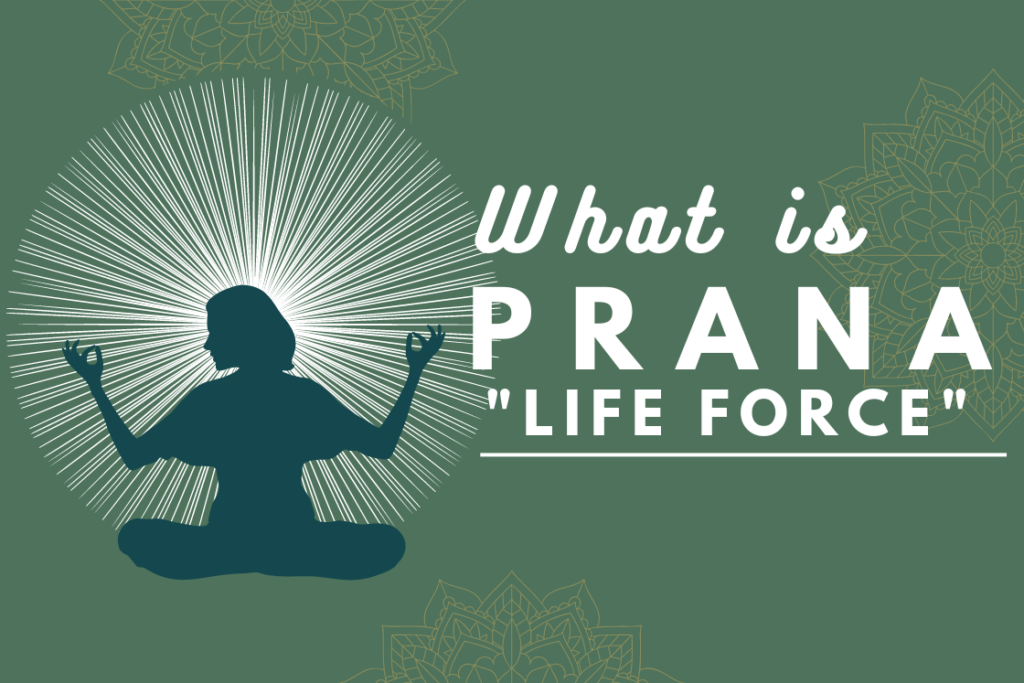
In general, the fundamental element that distinguishes a living being from an inanimate object is known as Prana.
For simplicity, Prana is sometimes referred to as the “breath” or the “air we inhale.” However, for a yogi, understanding Prana goes far beyond just breath.
Yogis view the breath as a tool a means to control, expand, or redirect Prana. This science of working with Prana is known as Pranayama.
What is Prana?
According to the yoga tradition, Prana is the vital energy in the body that keeps us alive. Because it sustains life, Prana is often called the “vital life force” or “vital energy” of a living being.
Only when Prana flows steadily can the voluntary and involuntary functions of the body take place. Breathing, digestion, heartbeat, walking, talking, and even thinking all are governed by the movement of Prana.
However, Prana is not limited to living beings. It also exists in inanimate objects, permeating all forms of matter.
To offer a broader view, the Vedic scriptures describe Prana as the power of the Supreme Self that manifests the entire universe and pervades all of creation.
The literal Meaning of Prana
In Sanskrit ‘Prana’ is spelled as ‘Praan‘ and its power is called ‘Praan shakti‘.
The Sanskrit term ‘Praan‘ is derived from the prefix ‘Pra‘ means ‘brings forth‘ and root ‘an’ means ‘movement‘. Prana means the force “which brings forth the movement”. And Prana Shakti is all about the manifestation which Prana brings; like life, matter, thoughts, etc. It’s the transformative force that converts energy into matter and matter into energy.
The force which makes us able to breathe, gives us an ability to think, lets us move body limbs freely is the force of Prana. Moreover, every other movement that is happening in all the objects of this universe is the force of Prana. This is why Prana is called the universal force that sums up the total of all forces in the universe.
To understand the meaning of prana, Swami Vivekananda explains Prana beautifully in his work. According to him;
At the beginning of creation, there is only this Akasha (space). But by the power of Prana, Akasha (space) manufactured into this universe.
Swami Vivekananda
Source of Prana
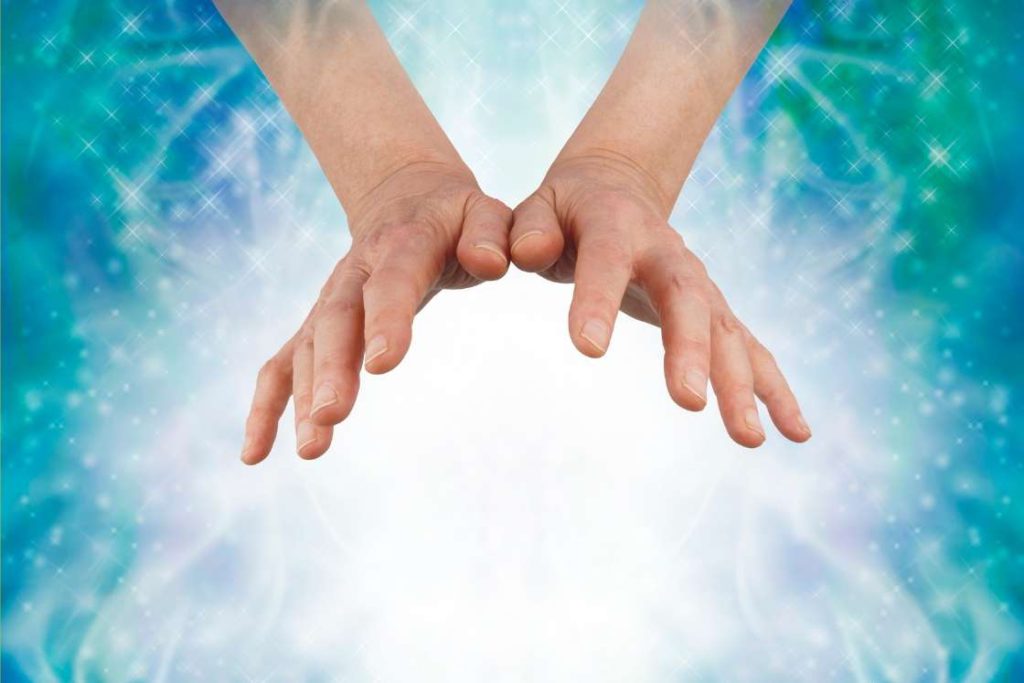
The three main sources of prana are the sun, earth, and cosmos. Prana from these sources called universal prana and we get it in different forms like food, air, water, and sunlight. However, it’s said, holy places, experience, contemplation on the supreme self also enhance the Prana level of the body.
Whether you are looking through eyes, breathing through the nose, sensing through the skin, or able to think of an event – Prana is working behind every subtle mechanism of the body.
According to Hindu philosophy, in our body, Prana is said to the companion of Atman, the soul. Prana lies with the soul at the heart center. The soul is the silent experiencer that perceives the physical world through the working of Prana; it enters and leaves the body with the Prana.
Before the physical body or mind begins to develop in an embryo in the mother’s womb, firstly soul comes into it and with the soul, Prana comes. Then pranic force (prana-shakti) combines the 5 elements to create the mind, senses, and the body. In this way, prana is superior to the body & mind, and getting control of Prana gives one control over the mind as well.
Also Read: Panch Tatva: Five Elements of Body
As mentioned in a study from “Institute for Consciousness Research, researchers said;
Our mind is able to think, concentrate, meditate, recite a mantra, or melt in devotion only with the help of ‘prana-shakti’, in the same way as the Power to create the universe resting in Shiva is solely the outcome of his Shakti.
How Prana Flows?
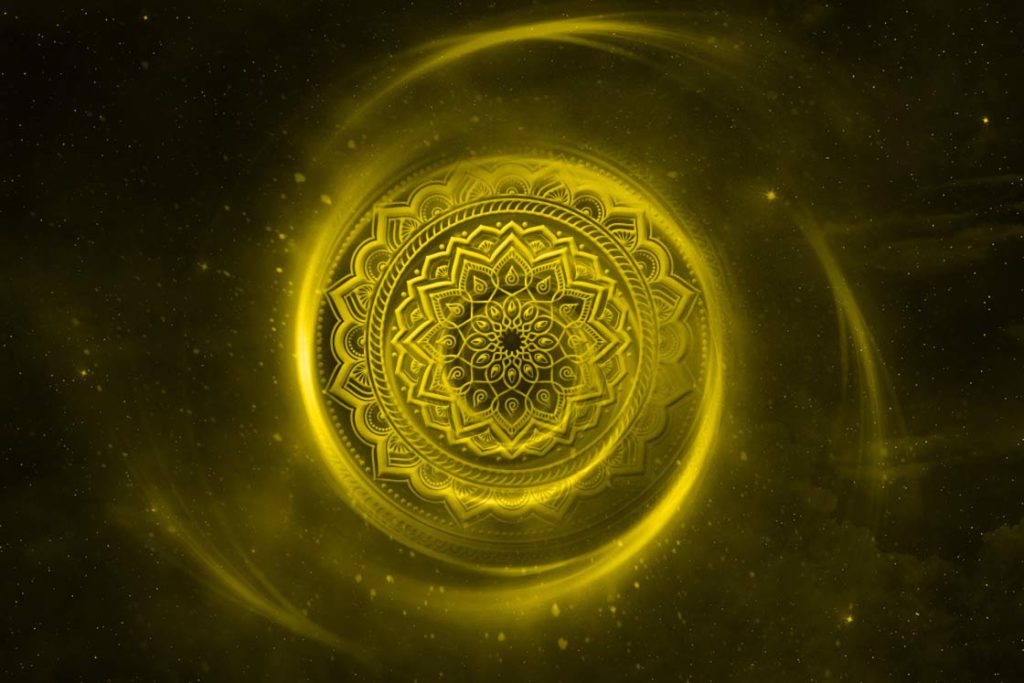
Our body is a complex system of organs and in order to make sure its proper functioning, the constant flow of prana is very important.
Prana flows in the body through subtle energy channels which in yogic terminology called the Nadis. The Nadis system is pervaded in the entire body in such a way that all the minor Nadis are connected from the three main Nadis Ida, Pingala, and Sushumna. These 3 main nadis lies in the subtle body along the spinal cord.
Also Read: The Three Main Nadis: Ida, Pingala, Sushumna
Where Ida and Pingala Nadi crisscross each other, at those points it meets with Sushumna Nadi, the central energy channel. And this way, this point of cross-section forms energy centers i.e. 7 chakras.
When Prana flows through Nadis, then it’s the work of Chakras to distribute it to other minor Nadis that are spread over the whole body. As soon as a chakra is fully filled up with Prana, it starts directing prana shakti in all possible directions by revolving on its axis. It’s called a balanced chakra when Prana is flowing through it in a balanced manner.
Prana flows in the form of Vayus
Yogis when observed the functions, intensity, and direction of flowing Prana in the Nadis, they found in the different region of the body, Prana act differently. It is not the same throughout the entire body. For example, in some regions, the direction of flow of Prana is upward (in chest, throat) while in other regions, it moves downwards.
In order to understand Prana more accurately, yogis divided Prana into 5 vayus.
What are Vayus?
The movement or the flow of prana is called the Vayu. Vayu literally translates as ‘Wind’. Like the wind is a force behind moving objects, Prana takes movement in the body in the form of Vayu.
Based on the flow of Prana in a particular region of the body, Prana can be divided into 5 vayus named Prana Vayu, Apana Vayu, Samana Vayu, Udana Vayu, and Vyana Vayu. These 5 are the major division of ‘Prana’ combinedly called the Pancha Pranas.
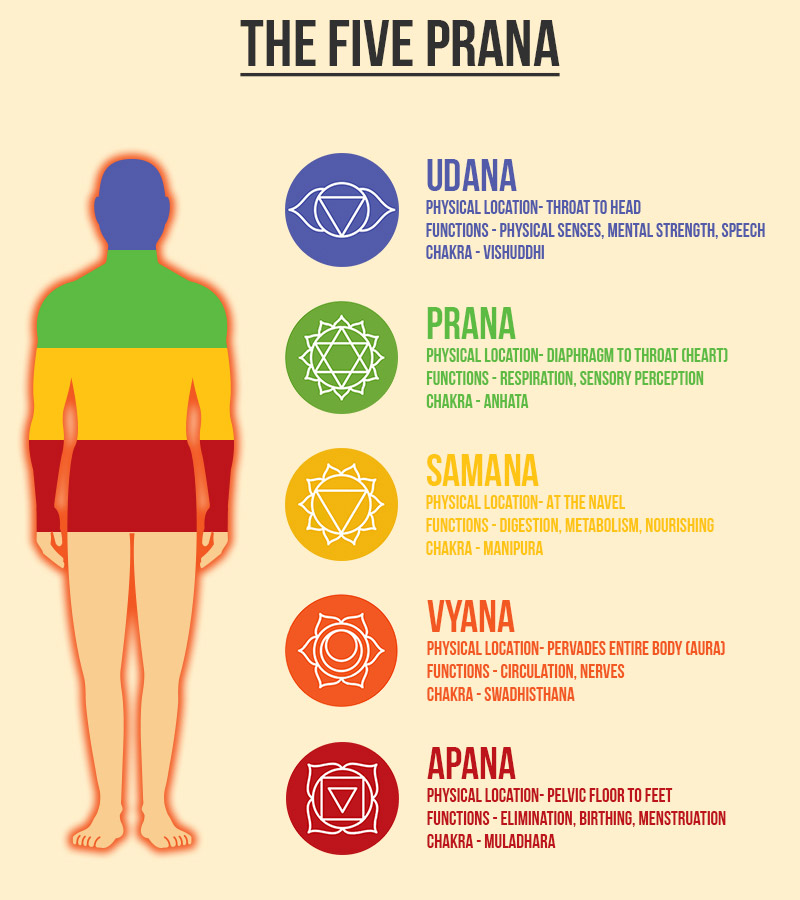
1. Prana Vayu
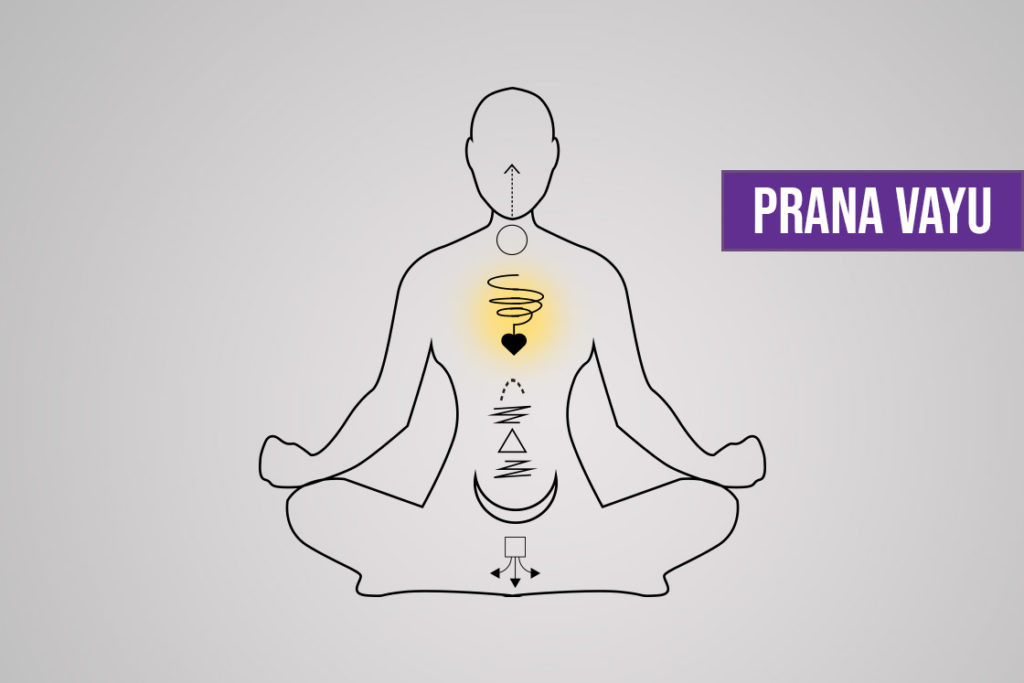
The first and most important type of Prana is prana vayu (To distinguish Prana from prana vayu, Prana is called Mahaprana). The flow of this vayu generally happens inwardly and upward direction.
On the physical level, prana vayu is responsible for the working of the respiratory system including the pumping of the heart, primary inhalation-exhalation process. Other than this, it also helps in swallowing and regurgitation food. It balances some physiological & psychological activities like eye-concentration, emotions & mental consistency.
The heart chakra is said the main seat of this vayu. Therefore imbalance in the quantity or a blockage in prana vayu can lead to depression, low-feeling & heart-related problems.
Also read: Prana mudra to balance prana vayu
Poses To Balance Prana Vayu
To balance the prana vayu one can practice the Asana in which the chest region is involved majorly. Some examples of asana to balance prana vayu, are standing Cobra, bridge pose, bow pose & camel pose.
2. Apana Vayu
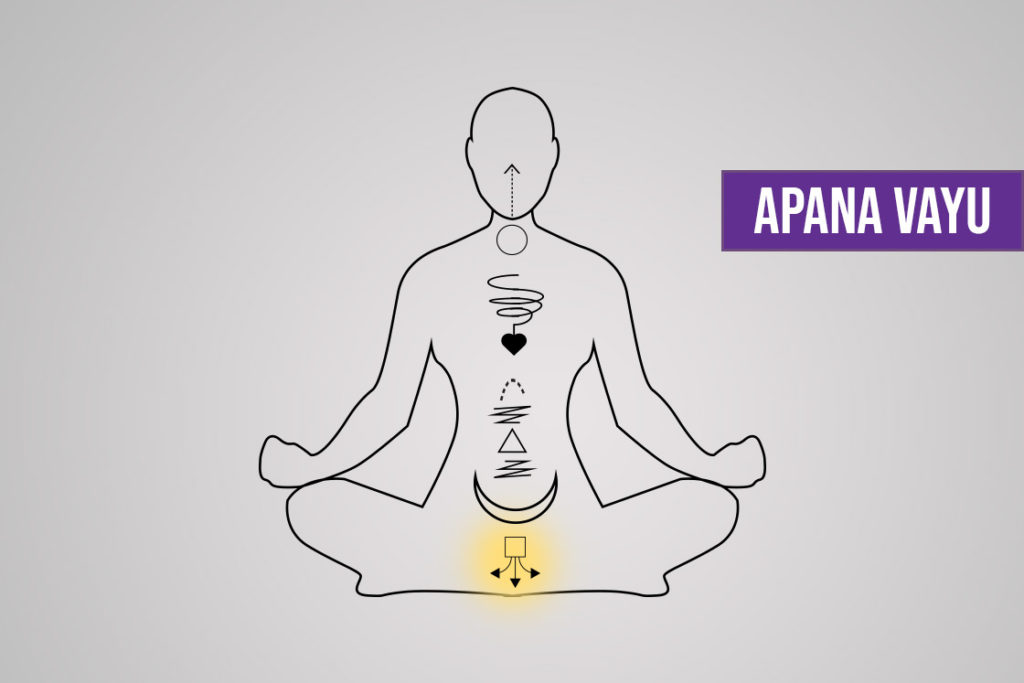
Apana Vayu flows in the opposite direction of prana vayu, i.e., in the downward direction. Generally, pranayama is aimed to redirect Apana Vayu to the higher energy centres and restrict its unnecessary flow out of the body. Its location is in Muladhara Chakra.
The main function of Apana Vayu is the elimination of waste as feces, gas, and urine. At the time of childbirth, Apana Vayu helps to create a smooth passageway for delivery. Other than this, Apana Vayu is also responsible for sexual stimulation, ejaculation & monthly menstrual cycle for women.
Major working area of apana vayu is core of the pelvic floor and it regulates the organs that lies in between navel to the perineum like urinary system, reproductive system, kidneys & the large intestine. An imbalance in Apana vayu can lead to diabetes, stomach related problems from poor elimination to laziness, tiredness, itching, depression and negativity.
Also read: Apana vayu mudra for heart
Poses To Balance Apana Vayu
To balance apana vayu, one should focus on the poses which cultivate awareness near the root chakra, For example – Tree Pose, Bound Angle Pose, Locust Pose, etc.
3. Samana Vayu
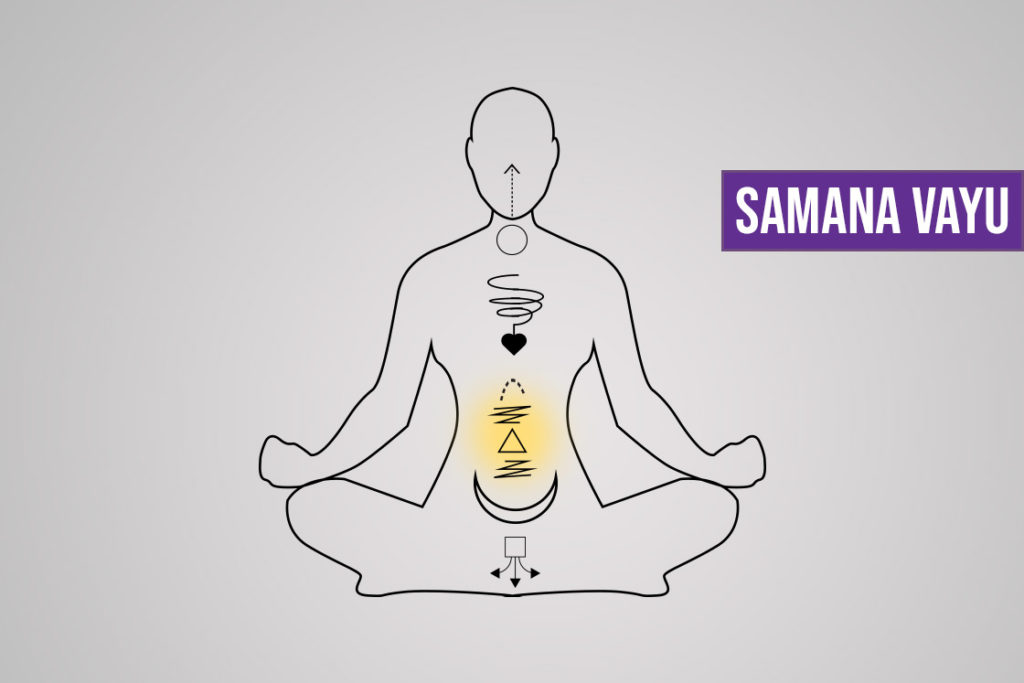
Samana means ‘equal’ (Equal in the sense of ‘Balancing’). It occupied between the working areas of prana & Apana Vayu. It hasn’t any movement in an upward or downward direction, but it works only in the navel region. Samana vayu focuses on the ‘fire element’ of the body and hence, stimulates Manipura Chakra.
It is responsible for energy utilized in the digestion process and working of digestive organs like the stomach, liver, large intestine. Samana vayu is both heating and cooling in nature which regulates the digestion process.
An imbalance of Samana Vayu can disturb the appetite of a person which brings weakness in the body. Moreover, it affects metabolism deficiency in the body.
Also read: Samana mudra for digestion
Poses To Balance Samana Vayu
Poses that creates extension or contraction in the navel region are good to balance the samana vayu. For example, Boat pose, Seated forward bend pose, etc.
4. Udana Vayu
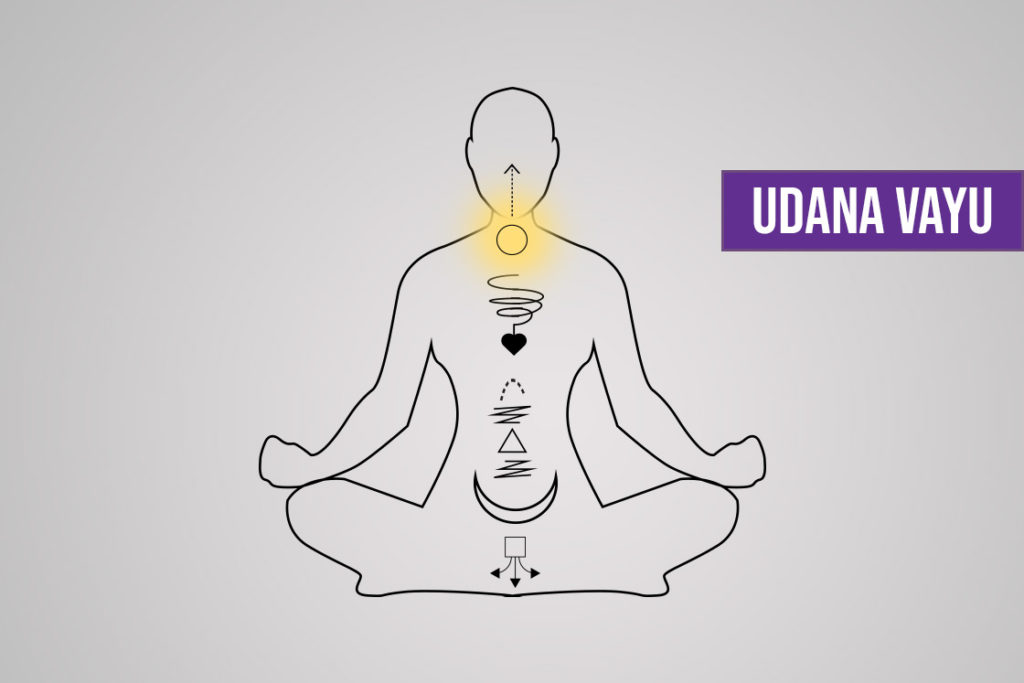
Udana means ‘Fly’ (fly in sense movement). With the help of Udana Vayu only, you can move the different organs of the body.
For example – Moving or rolling the hand through the shoulder, rounding the head & kicking through legs. All these possible because of Udana Vayu. This vital energy lies in the vishuddha chakra (Throat) and limbs above it.
On the physical level, Udana Vayu coordinates the neurons of the motor & sensory nervous system. This coordination helps in the proper movement of different organs of the body. Other than this, controlling the five physical senses are also handled by Udana Vayu.
Udana Vayu works in the different-different regions of the body. It resides between neck to head part, shoulder to fingertips (hands) & hips to the toe tips (legs). The deficiency of Udana Vayu can make a person paralyzed. Senses of the body won’t work correctly & it can lead to vision problems and deafness.
Also read: Udana mudra to balance udana vayu
Poses To Balance Udana Vayu
Poses that brings awareness to the shoulder and head region are best to balance the udana vayu in the body, For Example, Bridge Pose, Shoulder Stand, Plow Pose, Fish Pose, etc.
5. Vyana Vayu
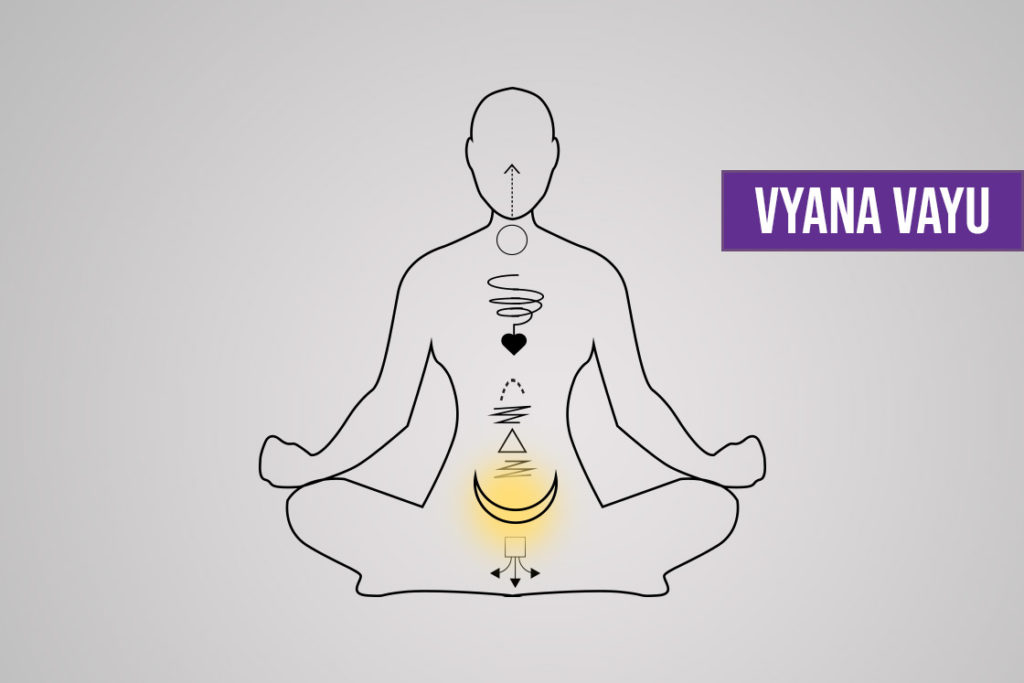
Vyana is the 5th and most integrated type of prana. The main function of vyana vayu is to facilitate reserve force into the deficient area of other pranas. It provides necessary nutrients to needed organs via blood flow.
Unlike the other 4 pranas, vyana vayu has no specific area working area in the body as it travels across the whole body & mind through the circulatory system.
An imbalance in Vyana vayu can lead to lack of coordination between sensory and motor neurons. It can further results in weak muscular movements or tight muscles. Also, by deficiency of this vayu, the body starts sweating a lot and sudden horripilation by fear becomes a very known phenomenon.
Also read: Vyana mudra for high blood pressure
Poses To Balance Vyana Vayu
Half-moon Pose and Eagle Pose can be practiced to redirect vyana vayu in a different part of the body.
Upaprana
Apart from the 5 major vayus, there are 5 minor pranas also, called Upaprana. 5 upa pranas are Naga, Kurma, Krikala, Devdatta, and Dhananjaya.
Whenever there comes blockages in 5 main prana vayus, upa-pranas works to bring that vayu in balance. Also, it is responsible for routine activities like eye blinking, yawning, sneezing, or burping, etc.
- Naga – Releases the gas that causes blockage in Prana and Apana Vayu in the form of burping, vomit, hiccups, etc.
- Kurma – This upa-prana controls the eyelid winking and keeps eyes moisturize.
- Krikala – It induces sneezing to clear the blockages in the respiratory system.
- Devdatta – This up-prana releases the gas in the form of Yawning. It balances samana vayu energy by expelling the gas after eating.
- Dhananjaya – It regulates the opening and closing of the heart valves and controls the fragmentation of a body after death.
5 Prana Vayus Chart
| 5 Pranas | Location | Function | Direction of Flow | Chakra | Element |
|---|---|---|---|---|---|
| Prana Vayu | Chest, Eyebrows centre | Inspiration, swallowing food | Upward | Heart chakra | Air |
| Apana Vayu | Pelvis | Elimination, outward movement | Downward | Root Chakra | Earth |
| Samana Vayu | Navel | Assimilation | Circular inward | Solar Plexus Chakra | Fire |
| Udana Vayu | Thorat | Metabolizing, speech, physical growth | Upward | Throat Chakra | Ether |
| Vyana Vayu | Whole body | Circulation | All direction | Sacral Chakra | Water |





Chala chakkaga vivarincharu, dhanyavadamulu
Thanks a lot for the detailed article on prana.
Very good. I found your site and I’m learning so much, I’m also a yoga professor, but I want to stay as a student because I want to learn so much. Thank you for all the info. Namaste
Thanks for this awesome article. Are there any hand mudras to balance all these Prana Vayus??
कोटि-कोटि धन्यवाद आशीष जी.। आपका हरेक लेख प्रशंसनीय है।
Very informative regarding pranas,sub pranas and the chakras. However totally wrong on the elements alignment with the pranas and chakras according to Tibet’s foremost guru of Buddhist Dzogchen Patrul Rinpoche. Who should we trust? Let Ashish’s conscience decide.
Hi, my name is Priya,
I am very impressed reading your article. I am writing a spiritual book. Is it ok if I take some of your ideas and give credit to you.
Please send an email. Thanks
Priya Anna
?
Thanks for writing Priya. You can take any ideas mentioned up here as a reference. Your credit will be appreciated. And sorry for such late response 🙁
VERY ESSENCIAL ARTICLE
One of the Best work..!
Excellent overview!
I am looking for a forum to reference the many on going prana experiences I am having.
Any guidance as to where to look?
Not interested in the usual Facebook craziness of negative people.
Thanks
Thank you, Dr Rishita. Could you please give any references for further reading?
Go for “The Power of Prana” by Master Stephen Co and “Prana: The Secret of Yogic Healing” by Atreya. It will provide you a more detailed description of 5 Pranas and their power.
Excellent work
Is’t there is Ten types of vayuin human body-karkal ,kuram, naag,devdutt& last one is dannanjai vayu.
Yes, apart from 5 Prana vayu there are 5 upa pranas vayus lies within human body.
This is one of the best write ups , I have gone through so far, It is clear cut demonstration through the writings and the necessary displays ; I am impressed with the commitment, you have for explaining a very difficult subject in lucid manner . your commitment to Yoga is visible through your explanation , and to me , it is really commendable job done by you.
thanks very much for sharing your article to one and all,
yours sincerely ,
kaladhar . kakarla .
.
Thanks,a lot .Very nicely explained with diagramme about Vayu in Human body .